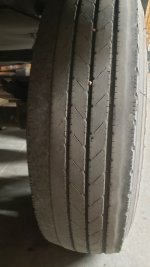SLO
Well-known member
Sorry for the length of post. I have always had tire excessive wear and cupping on the inside and outside edges of all four ST235/85R16 G rates Sailun tires. I would generally attribute that to under inflation and some scuffing on tight, hard surface, turns. However, I’ve always kept inflation at 110 psi. Tire wear has been the same with original axles and with new IS suspension. When I recently had my tires installed on my new wheels the tire dealer suggested over inflation could cause this wear. WHAT!!!!
In my research I found this:
Particularly this paragraph:
“Over-inflated tires are harder than properly inflated tires, making them more susceptible to tread surface cutting, punctures and impact breaks. Over-inflation also changes a tire’s footprint, which can affect tire traction and lead to irregular wear patterns. TMC Recommended Practice RP 219B, Radial Tire Wear Conditions and Causes, indicates that the probable cause of excessive wear found on both shoulder ribs of trailer tires in the study was likely over-inflation. The edges of an over-inflated tire pull away from
the ground and only make contact when they skip across road imperfections, or when the tire bounces with enough force to press the edges into brief contact with the road. That scuffing of the rubber causes rapid and irregular edge wear. This accelerated tread wear can cost 7 to 15 percent of the tire life.”
Sailun tire inflation chart:
At 110 psi the load capacity is 4400 lbs per tire. I haven’t had individual tires weighed but I doubt they are close to 4400 lbs. My weight on trailer axles is 12,680 lbs. My guess would be no more than 3860 lbs per wheel, which would be 90 psi. I know most who have posted your tire inflation figure, has stated 110 psi. Thoughts, feedback, disagreements on this uneven tire wear caused by over inflation would be appreciated.
In my research I found this:
Particularly this paragraph:
“Over-inflated tires are harder than properly inflated tires, making them more susceptible to tread surface cutting, punctures and impact breaks. Over-inflation also changes a tire’s footprint, which can affect tire traction and lead to irregular wear patterns. TMC Recommended Practice RP 219B, Radial Tire Wear Conditions and Causes, indicates that the probable cause of excessive wear found on both shoulder ribs of trailer tires in the study was likely over-inflation. The edges of an over-inflated tire pull away from
the ground and only make contact when they skip across road imperfections, or when the tire bounces with enough force to press the edges into brief contact with the road. That scuffing of the rubber causes rapid and irregular edge wear. This accelerated tread wear can cost 7 to 15 percent of the tire life.”
Sailun tire inflation chart:
At 110 psi the load capacity is 4400 lbs per tire. I haven’t had individual tires weighed but I doubt they are close to 4400 lbs. My weight on trailer axles is 12,680 lbs. My guess would be no more than 3860 lbs per wheel, which would be 90 psi. I know most who have posted your tire inflation figure, has stated 110 psi. Thoughts, feedback, disagreements on this uneven tire wear caused by over inflation would be appreciated.
Last edited:






